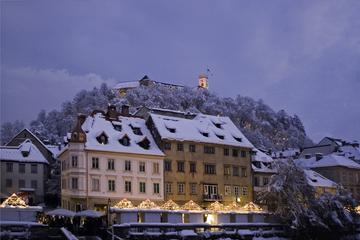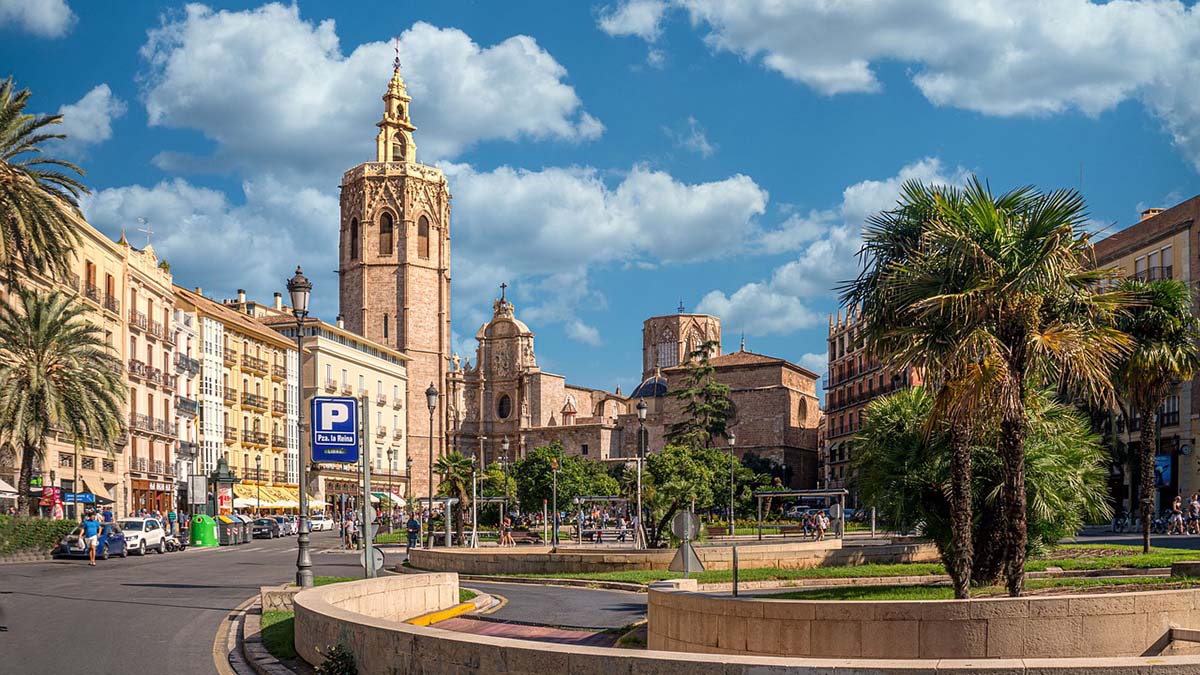
by Inka Piegsa-Quischotte
 When, just over a week ago, I arrived in Valencia, Spain’s third largest city located on the Mediterranean and full of history, I did so, literally, with a bang. It’s the time of year when a spectacular festival, known as Las Falles, is celebrated, culminating on the 19th of March with a parade of gigantic ninots, papier-mâché effigies which are, at the end, burnt in a massive bonfire to chase winter out and welcome spring. Fireworks, crackers, you name it, anything which makes noise and has color will assault the senses.
When, just over a week ago, I arrived in Valencia, Spain’s third largest city located on the Mediterranean and full of history, I did so, literally, with a bang. It’s the time of year when a spectacular festival, known as Las Falles, is celebrated, culminating on the 19th of March with a parade of gigantic ninots, papier-mâché effigies which are, at the end, burnt in a massive bonfire to chase winter out and welcome spring. Fireworks, crackers, you name it, anything which makes noise and has color will assault the senses.
What I didn’t know though, was that two week prior to the main event and at 1:30 in the afternoon, crackers and fireworks are already launched on a daily basis. So, when I stepped off the train at exactly this hour, a mere coincidence, I found myself engulfed in noise and smoke which could have been mistaken for a war scene. What a start to my trip to Valencia! But, my purpose wasn’t Las Falles, or the futuristic City of the Arts and Sciences built in the now dry bed of the river Turia, nor the many Gothic and baroque buildings or the interesting museums, no, my priority was to find the Holy Grail.
 The story of the Holy Grail or chalice, which is the cup Jesus supposedly used during the Last Supper, has fired the imagination over centuries. Did it survive, where was it, is the story really true?
The story of the Holy Grail or chalice, which is the cup Jesus supposedly used during the Last Supper, has fired the imagination over centuries. Did it survive, where was it, is the story really true?
It was first mentioned in Perceval le Gallois, a medieval romantic poem by Chretien de Troyes, followed by more Arthurian literature, most famously Joseph of Arimathea by Robert de Boron. Joseph receives the grail from an apparition of Jesus, takes it to Great Britain and founds a dynasty of keepers of the grail which include Perceval. King Arthur and his knights are involved in the quest for the Holy Grail which at one time, supposedly also ended in the hands of the Knights Templar.
Another version has it, that the grail was taken to Rome by St. Peter and then, in the 13th century, to Spain by St. Lawrence. More literature, fiction as well as scientific books, followed. The grail and the quest for it, is a mayor them in paintings as well as in Tennyson’s 19th century Arthurian cycle. Not to mention movies and, yes, even a rock band.
 Given the many legends, it is not surprising that there are more than one chalice which lay claim to being the ‘real thing’. It will appear though that the chalice kept in the cathedral of Valencia has the most valid claim to authenticity. At least, it has been the official papal chalice for centuries, last used as such by Pope Benedict XVI in June 2006. It was given to the cathedral of Valencia by King Alfonso V of Aragon in 1436.
Given the many legends, it is not surprising that there are more than one chalice which lay claim to being the ‘real thing’. It will appear though that the chalice kept in the cathedral of Valencia has the most valid claim to authenticity. At least, it has been the official papal chalice for centuries, last used as such by Pope Benedict XVI in June 2006. It was given to the cathedral of Valencia by King Alfonso V of Aragon in 1436.
I have always been fascinated by medieval history and the many legends, mysteries and stories surrounding the Holy Grail certainly add a touch of romance to the times. Living at a distance of only two hours by train, I decided to go on my own personal chase of the chalice.
After my eyes and ears had cleared of the noise and smoke (it only lasts for 30 minutes), and after admiring the neo-classic train station with its colorful Valencia ceramics, I made my way to the cathedral.
 It’s very easy to get around Valencia’s historic center on foot, leading past several other landmarks like the Central Market and La Lonja de la Seda, the silk exchange. The cathedral was consecrated in 1238 and is basically a Gothic structure. Built over a former Visgothic cathedral which was turned into a mosque during the occupation by the Arabs, the cathedral also shows Romanesque, Renaissance, Baroque and Neo Classical elements. What first catches the eye is Miguelete, the octagonal bell tower which looms up near the main portal and can be climbed, offering a fabulous view over the city, port and river.
It’s very easy to get around Valencia’s historic center on foot, leading past several other landmarks like the Central Market and La Lonja de la Seda, the silk exchange. The cathedral was consecrated in 1238 and is basically a Gothic structure. Built over a former Visgothic cathedral which was turned into a mosque during the occupation by the Arabs, the cathedral also shows Romanesque, Renaissance, Baroque and Neo Classical elements. What first catches the eye is Miguelete, the octagonal bell tower which looms up near the main portal and can be climbed, offering a fabulous view over the city, port and river.
A richly decorated interior, particularly the blue and gold ceilings and many important paintings leaves art lovers mute in admiration. And then, on your right, in a chapel of its own, there it is: the Holy Grail. I was a bit disappointed, because you can’t really get close to see the cup. Not only is it kept in an illuminated glass show case, but it’s also roped off quite a distance away. Even so, remembering all the stories about the quest of finding the grail and then standing there, close to what many believe and archaeologists have confirmed to be the chalice used at the Last Supper, gave me a frisson. Experiencing history up close and personal always is a thrill.

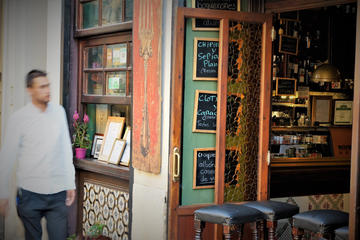
Valencia Walking Tour & Paella Meal
If You Go:
Valencia is a worthwhile destination at any time of the year, but during the Falles it gets very crowded and more expensive.
The Metropolitan Cathedral–Basilica of the Assumption of Our Lady of Valencia website
If you can manage to visit the cathedral at noon on a Thursday, you can witness a unique spectacle: El Tribunal de las Aguas, or water court. 12 farm workers sit near the main portal in judgment over all disputes over the distribution of water from the river Turia. Established in the Middle Ages, this tradition lives on to the present day, not as folklore but as a real court whose decisions are final and binding.
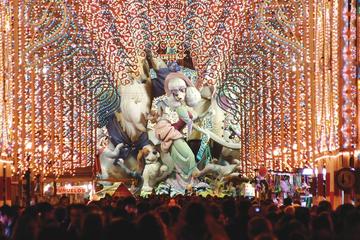
Private Valencia Tour During Falles Festival – 15th to 19th of March
About the author:
Inka Piegsa-quischotte is an ex-attorney turned travel writer and novelist. She writes for online travel magazines and has two novels and a travel guide to Galicia/Spain published. She currently lives in Spain. Blog: www.glamourgrannytravels.com/
Photo credits:
Valencia top photo by ebroslu from Pixabay
All other photos are by Inka Piegsa:
Main Cathedral Portal
Holy Grail
Baroque Ceiling
Altar in Cathedral
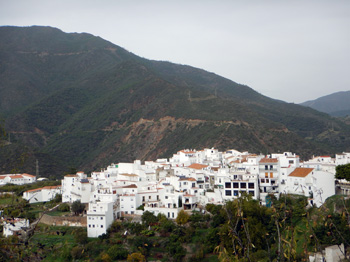
 Created for mules and packhorses, the narrow streets are steep and best experienced on foot. We park the car and explore this village of Moorish roots dating back to 1448. A map painted on a whitewashed wall provides a guide around the historic section. We wander the almost perpendicular avenues, passing quaint tiled courtyards decorated with flowers and greenery in terracotta pots. The pristine white houses accented with charming old wooden doors are postcard worthy. We soon reach Juana de Escalante Passage, the remainder of the centre of the old Muslim town, tucked in a side street.
Created for mules and packhorses, the narrow streets are steep and best experienced on foot. We park the car and explore this village of Moorish roots dating back to 1448. A map painted on a whitewashed wall provides a guide around the historic section. We wander the almost perpendicular avenues, passing quaint tiled courtyards decorated with flowers and greenery in terracotta pots. The pristine white houses accented with charming old wooden doors are postcard worthy. We soon reach Juana de Escalante Passage, the remainder of the centre of the old Muslim town, tucked in a side street.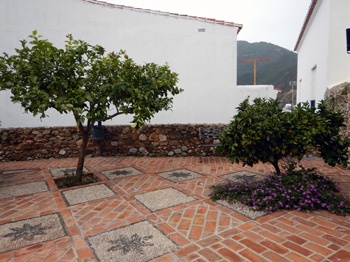 This was the site of a Moorish rebellion in 1568. The niece of the cleric, Juana de Escalante, stopped the rebels by throwing stones at them from the tower until aid came from Marbella. All that remains is the site the tower once stood on, the round archway and the courtyard through which horses passed through on the way to the stables. Standing there I sense the walls could tell many stories over the centuries. I look down and observe the detailed tile work on the ground. It is a work of art.
This was the site of a Moorish rebellion in 1568. The niece of the cleric, Juana de Escalante, stopped the rebels by throwing stones at them from the tower until aid came from Marbella. All that remains is the site the tower once stood on, the round archway and the courtyard through which horses passed through on the way to the stables. Standing there I sense the walls could tell many stories over the centuries. I look down and observe the detailed tile work on the ground. It is a work of art. Throughout the village is a series of water fountains providing fresh water for the inhabitants over the centuries. The fountains are as attractive as functional; decorated with blue and white tiles, some painted with scenes of the area. The mountain water is prized for its purity.
Throughout the village is a series of water fountains providing fresh water for the inhabitants over the centuries. The fountains are as attractive as functional; decorated with blue and white tiles, some painted with scenes of the area. The mountain water is prized for its purity.
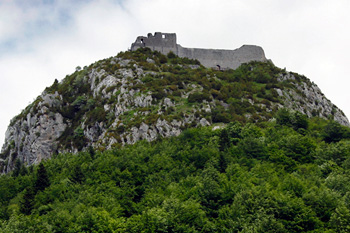
 The ruin of Montségur perches on a hilltop in the foothills of the Pyrenees. My arduous climb to this lonely crag is rewarded with panoramic views of lush hillsides dotted with purple blooming wild sage and silent sheep. All that remains of the castle are crumbling walls and part of a keep. A sighing wind whispers over the walls.
The ruin of Montségur perches on a hilltop in the foothills of the Pyrenees. My arduous climb to this lonely crag is rewarded with panoramic views of lush hillsides dotted with purple blooming wild sage and silent sheep. All that remains of the castle are crumbling walls and part of a keep. A sighing wind whispers over the walls.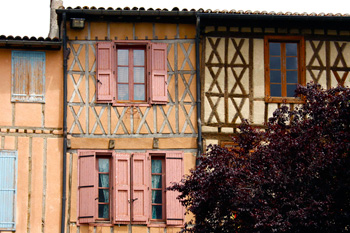 In contrast to the desolate loneliness of Montségur castle, Mirepoix is a bustling market town. Pastel coloured, half-timbered houses above wood frame arcades line the main square. Gargoyles on the church supervise the crowds around the curlicue adorned market. At the other end of the square sits the 14th century town hall. Each decorative wooden beam has a different carved head, demon, or animal.
In contrast to the desolate loneliness of Montségur castle, Mirepoix is a bustling market town. Pastel coloured, half-timbered houses above wood frame arcades line the main square. Gargoyles on the church supervise the crowds around the curlicue adorned market. At the other end of the square sits the 14th century town hall. Each decorative wooden beam has a different carved head, demon, or animal. On the opposite end of the spectrum from Montségur’s crumbling castle are the immaculately restored walls, bastions, and towers of Carcassonne’s Cité. Viewed across vineyards, the fortress stands as if from a fairy tale. Fortified since Roman times, Carcassonne was a Cathar stronghold in the Middle Ages. In the 1800s, Viollet-le-Duc imaginatively restored the double walls and the chateau they shelter. At a time when so many of France’s monuments were being neglected, he rallied for restoration. The project took fifty years and sadly, he did not live to see its glorious completion.
On the opposite end of the spectrum from Montségur’s crumbling castle are the immaculately restored walls, bastions, and towers of Carcassonne’s Cité. Viewed across vineyards, the fortress stands as if from a fairy tale. Fortified since Roman times, Carcassonne was a Cathar stronghold in the Middle Ages. In the 1800s, Viollet-le-Duc imaginatively restored the double walls and the chateau they shelter. At a time when so many of France’s monuments were being neglected, he rallied for restoration. The project took fifty years and sadly, he did not live to see its glorious completion.
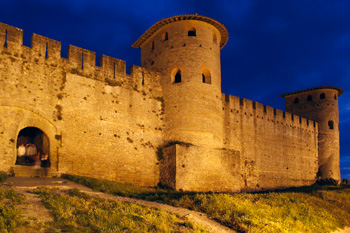 Inside the fortress, crowded narrow streets are lined with souvenir stands, restaurants, and half-timbered houses. I wander past patrons dining at tables under a leafy canopy, artists painting water colours and children in crusader outfits brandishing plastic swords. Two falconers, with their beady-eyed charges gripping their leather-gloved arms, add to the medieval atmosphere. On the grass lices between the long inner and outer sheer rock walls, I stroll in relative solitude past black slate roofed towers and square cut bastions. Carcassonne is a World Heritage Site and the fortress, while impressive by day, is stunningly lit at night. As the evening sky fades to a dusky blue and the spotlights come on, the fairy tale towers and walls glow golden. I readily imagine a centurion slowly patrolling the walls.
Inside the fortress, crowded narrow streets are lined with souvenir stands, restaurants, and half-timbered houses. I wander past patrons dining at tables under a leafy canopy, artists painting water colours and children in crusader outfits brandishing plastic swords. Two falconers, with their beady-eyed charges gripping their leather-gloved arms, add to the medieval atmosphere. On the grass lices between the long inner and outer sheer rock walls, I stroll in relative solitude past black slate roofed towers and square cut bastions. Carcassonne is a World Heritage Site and the fortress, while impressive by day, is stunningly lit at night. As the evening sky fades to a dusky blue and the spotlights come on, the fairy tale towers and walls glow golden. I readily imagine a centurion slowly patrolling the walls.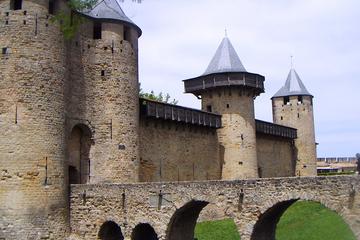
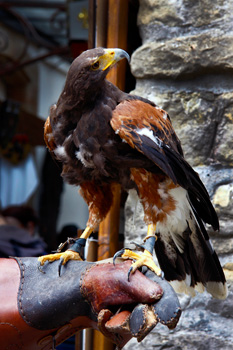 If You Go:
If You Go: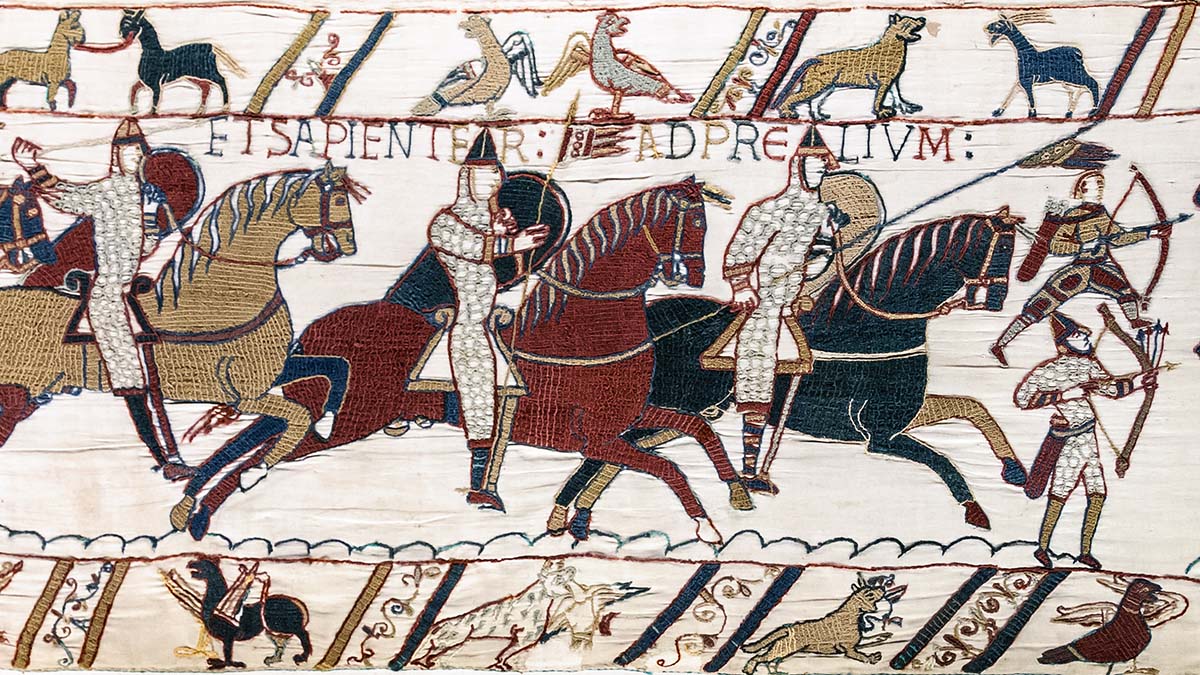
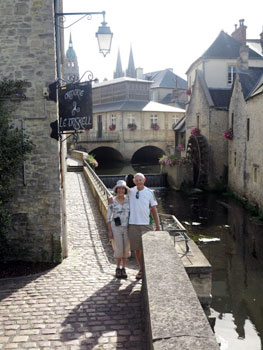 It’s Remembrance Day, 2014 and I’m interlocking the sleeves of my parents’ Air Force jackets. They are arm in arm once more, laid out on the bed. Mum, a coding and deciphering officer with the RAF, and Dad, an air observer/navigator with the 10th Squadron, Bomber Command, met at a dance in Gander, Newfoundland in December, 1944. They’d both already served five long years. I salute them. Then I hug their blue-gray wool serge, touch their caps, and straighten their belts.
It’s Remembrance Day, 2014 and I’m interlocking the sleeves of my parents’ Air Force jackets. They are arm in arm once more, laid out on the bed. Mum, a coding and deciphering officer with the RAF, and Dad, an air observer/navigator with the 10th Squadron, Bomber Command, met at a dance in Gander, Newfoundland in December, 1944. They’d both already served five long years. I salute them. Then I hug their blue-gray wool serge, touch their caps, and straighten their belts.
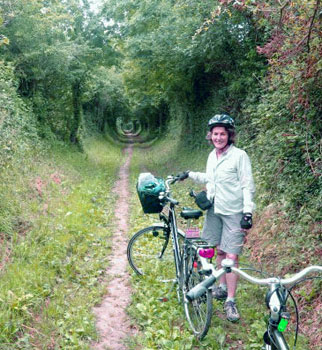 A visit to Notre-Dame Cathedral’s Romanesque and Norman-Gothic edifice which pre-dates Mont-Saint-Michel was a must-see. It was consecrated in the fourth-century and flourished in King William’s reign. Its façade, chapter-house labyrinth, choir, as well as its fifteenth-century frescoes of angel musicians in the crypt, all captivate.
A visit to Notre-Dame Cathedral’s Romanesque and Norman-Gothic edifice which pre-dates Mont-Saint-Michel was a must-see. It was consecrated in the fourth-century and flourished in King William’s reign. Its façade, chapter-house labyrinth, choir, as well as its fifteenth-century frescoes of angel musicians in the crypt, all captivate.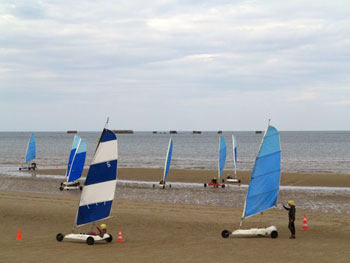 A yearning to be in the open air brings us to Velos Location: We rent bikes for eight hours at 16 Euros apiece and are transported to countryside where we hear the farmer’s tractor mowing hay. Or are those really tanks approaching? The trees that line the roads look mature, but aren’t they uniformly pushing the seventy years since peace was brokered? In 1944, trees provided fuel or defensive barriers on low-tide beaches, and their removal meant less shelter for an enemy. Today, those same trees flicker from shadow to light like newsreels, transmitting ticker tape noises to our spokes, and crank us forward.
A yearning to be in the open air brings us to Velos Location: We rent bikes for eight hours at 16 Euros apiece and are transported to countryside where we hear the farmer’s tractor mowing hay. Or are those really tanks approaching? The trees that line the roads look mature, but aren’t they uniformly pushing the seventy years since peace was brokered? In 1944, trees provided fuel or defensive barriers on low-tide beaches, and their removal meant less shelter for an enemy. Today, those same trees flicker from shadow to light like newsreels, transmitting ticker tape noises to our spokes, and crank us forward.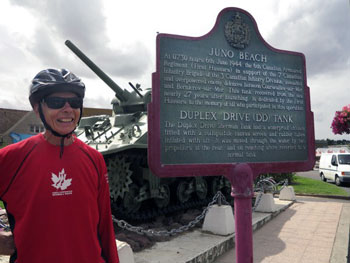 We chance upon the British Cemetery of War Graves of Bazenville-Ryes en route to Juno. Among its nearly 1000 souls, it shares the high ground with British, American, Canadian and German soldiers. The only borders here are lovely weed-free plantings of roses, oregano and lavender.
We chance upon the British Cemetery of War Graves of Bazenville-Ryes en route to Juno. Among its nearly 1000 souls, it shares the high ground with British, American, Canadian and German soldiers. The only borders here are lovely weed-free plantings of roses, oregano and lavender.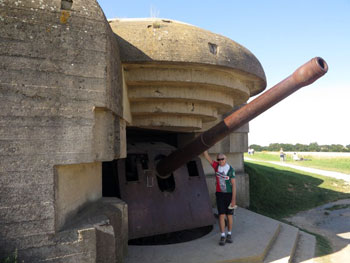 Longues-sur-Mer, the German Battery, still houses a 150-millimeter gun and four bunkers. Martine conducts the tour of the only battery to retain its original naval gun. These powerful long-range guns could have devastated had they functioned properly. The four guns were up, ready and firing over the 20-kilometer range, but a sand dune blocked the telescopic view for the shiny new range-finder still in its box. Without a range-finder, the guns fired blindly like big barking dogs, until direct hits silenced two of them just before the surrender.
Longues-sur-Mer, the German Battery, still houses a 150-millimeter gun and four bunkers. Martine conducts the tour of the only battery to retain its original naval gun. These powerful long-range guns could have devastated had they functioned properly. The four guns were up, ready and firing over the 20-kilometer range, but a sand dune blocked the telescopic view for the shiny new range-finder still in its box. Without a range-finder, the guns fired blindly like big barking dogs, until direct hits silenced two of them just before the surrender.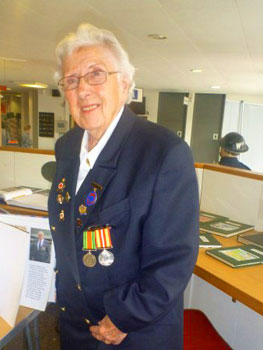 This summer, 2014, we visited Portsmouth’s D-Day Museum to view the recently-completed Overlord Tapestry that commemorates D-Day. I met Mary Turner Verrier, a 91-year-old Red Cross Nurse and veteran of Dieppe, Dunkirk and D-Day. Mary treated casualties of war, both civilians and servicemen, primarily for flash burns.
This summer, 2014, we visited Portsmouth’s D-Day Museum to view the recently-completed Overlord Tapestry that commemorates D-Day. I met Mary Turner Verrier, a 91-year-old Red Cross Nurse and veteran of Dieppe, Dunkirk and D-Day. Mary treated casualties of war, both civilians and servicemen, primarily for flash burns.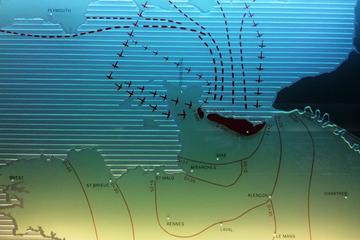
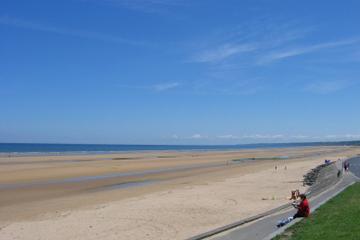
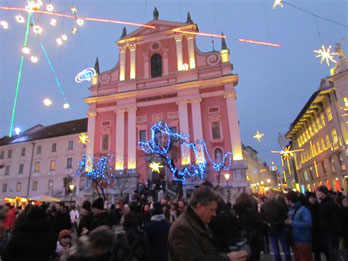
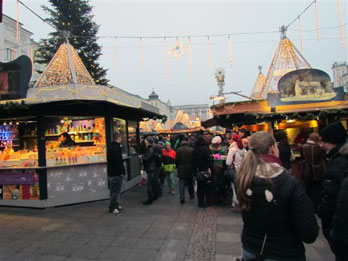 No one remembers its history exactly but there is some thought that the fair originated in the middle ages. In 1697 the historian Christoph Wagenseil, a native of Nuremberg, mentioned the Christkindlesmarkt in the second history of the town where he described the event much as it is celebrated today.
No one remembers its history exactly but there is some thought that the fair originated in the middle ages. In 1697 the historian Christoph Wagenseil, a native of Nuremberg, mentioned the Christkindlesmarkt in the second history of the town where he described the event much as it is celebrated today.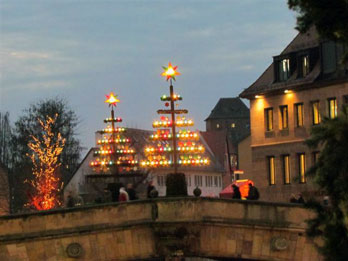 My wife and I are visiting with relatives and enjoying the brisk air. There are golden angels hanging everywhere. This is a very popular festival in Germany and one that is also enjoyed by tourists. We pass by rows and rows of colorful booths, each filled with such holiday delights as glittering Christmas tree decorations, clever toys from Nuremberg craftsmen, marvelous Lebkuchen, a cookie usually made from honey, spices, nuts, or candied fruit, and pungent gingerbread. Then are also figurines of the Christ Child in his crib, surrounded by Mary, Joseph, and adoring shepherds. Faintly in the distance there is music and as we draw nearer we hear the sound of a children’s choir performing a variety of Christmas songs. We linger awhile to enjoy the moment and the spirit of Christmas.
My wife and I are visiting with relatives and enjoying the brisk air. There are golden angels hanging everywhere. This is a very popular festival in Germany and one that is also enjoyed by tourists. We pass by rows and rows of colorful booths, each filled with such holiday delights as glittering Christmas tree decorations, clever toys from Nuremberg craftsmen, marvelous Lebkuchen, a cookie usually made from honey, spices, nuts, or candied fruit, and pungent gingerbread. Then are also figurines of the Christ Child in his crib, surrounded by Mary, Joseph, and adoring shepherds. Faintly in the distance there is music and as we draw nearer we hear the sound of a children’s choir performing a variety of Christmas songs. We linger awhile to enjoy the moment and the spirit of Christmas.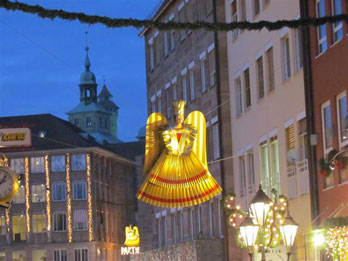 There are booths filled with such specialties as savory-smelling roasted sausages, delicately grilled herrings, and my favorites schaschlik (skewered meat usually lamb) and mulled wine. We partake of the mulled wine to help warm us in the cool winter air. There are sweets, of course, all kinds of traditional candies and all manner of cookies. The Nuremberg Christkindlsmarkt is full of wonderful sights, sounds and smells. It symbolizes for adults unforgettably beautiful childhood memories and it is little short of paradise for all age groups. However, it is also important to discover other Christmas markets in Europe.
There are booths filled with such specialties as savory-smelling roasted sausages, delicately grilled herrings, and my favorites schaschlik (skewered meat usually lamb) and mulled wine. We partake of the mulled wine to help warm us in the cool winter air. There are sweets, of course, all kinds of traditional candies and all manner of cookies. The Nuremberg Christkindlsmarkt is full of wonderful sights, sounds and smells. It symbolizes for adults unforgettably beautiful childhood memories and it is little short of paradise for all age groups. However, it is also important to discover other Christmas markets in Europe.
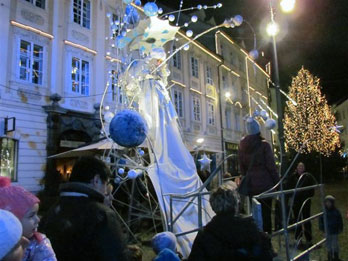 The
The 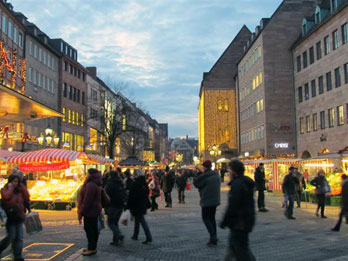 My wife and I and my cousin and his wife walked toward the Ljubljanica River. This year the Christmas season began on Tuesday, December 3, 2013 with the decoration of the town’s buildings and Christmas trees with lights that were switched on throughout the city. There was about 64 kilometers of lighting sculptures and light garlands installed on the trees and seven spruces located in the Preseren Trg (Market), at Figovec, in Levstikov Trg, Pod Tranco, next to the City Hall and in its Atrium as well as on the Ljubljana Castle. This was the beginning of the festive season that lasted until the December 31 New Year’s Eve celebration.
My wife and I and my cousin and his wife walked toward the Ljubljanica River. This year the Christmas season began on Tuesday, December 3, 2013 with the decoration of the town’s buildings and Christmas trees with lights that were switched on throughout the city. There was about 64 kilometers of lighting sculptures and light garlands installed on the trees and seven spruces located in the Preseren Trg (Market), at Figovec, in Levstikov Trg, Pod Tranco, next to the City Hall and in its Atrium as well as on the Ljubljana Castle. This was the beginning of the festive season that lasted until the December 31 New Year’s Eve celebration.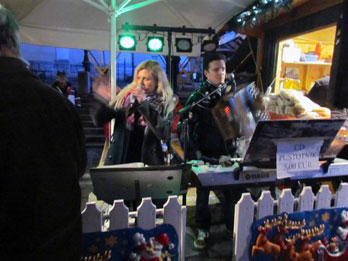 Along the banks of the Ljubljanica River there were wooden stalls set up, decorated with Christmas ornaments and the scent of sausage; pastries, roasted chestnuts, and hot mulled wine filled the air. Vendors were also selling an assortment of unique Christmas gifts. All around us the varied colored lights begin to sparkle. The Franciscan church of the Annunciation on Preseren Square its pink façade aglow and its statuesque columns were bathed in white lights highlighting the face of the church. On the steps there was a crowd of people exiting while others patiently waited to enter the church to view the nativity scene and numerous religious displays inside.
Along the banks of the Ljubljanica River there were wooden stalls set up, decorated with Christmas ornaments and the scent of sausage; pastries, roasted chestnuts, and hot mulled wine filled the air. Vendors were also selling an assortment of unique Christmas gifts. All around us the varied colored lights begin to sparkle. The Franciscan church of the Annunciation on Preseren Square its pink façade aglow and its statuesque columns were bathed in white lights highlighting the face of the church. On the steps there was a crowd of people exiting while others patiently waited to enter the church to view the nativity scene and numerous religious displays inside. New this year to the festivities was an open-air life-size outdoor Nativity scene with a wooden manger, figures of the three Magi, shepherds, sheep and other animals all made out of straw. This was made by the Anton Kravanja Christmas Cribs Association.
New this year to the festivities was an open-air life-size outdoor Nativity scene with a wooden manger, figures of the three Magi, shepherds, sheep and other animals all made out of straw. This was made by the Anton Kravanja Christmas Cribs Association.